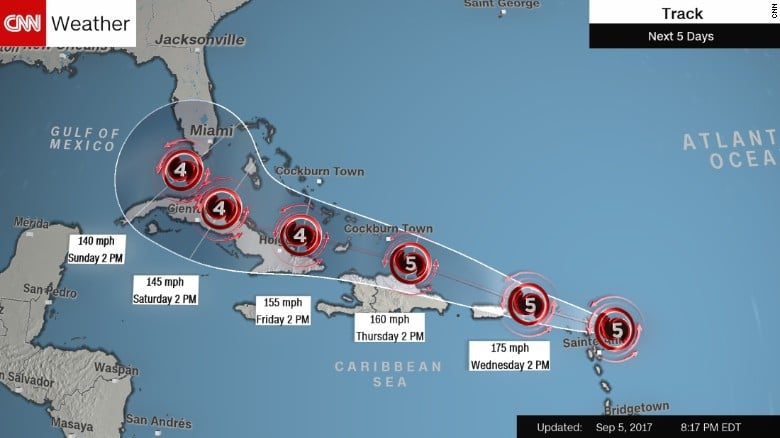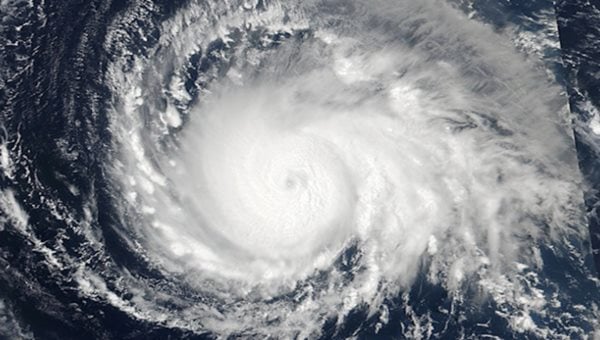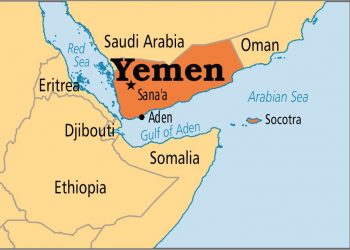Hurricane Irma, one of the most forceful Atlantic storms of the century, churned across the ocean on Tuesday on a collision course with Puerto Rico and the Virgin Islands, bearing down on the northern Caribbean with a devastating mix of fierce winds, surf and rain.
The eye of Irma, a Category 5 storm packing winds of 185 miles per hour (295 km per hour), was expected to sweep through the northern Leeward Islands, east of Puerto Rico, on Tuesday night or early Wednesday, en route to a Florida landfall on Saturday, the US National Hurricane Center (NHC) in Miami reported.
The threat posed to the US mainland by Irma, described by NHC forecasters as a “potentially catastrophic” storm, loomed as Texas and Louisiana continued to reel from widespread destructive flooding from Hurricane Harvey.
President Donald Trump on Tuesday approved pre-landfall emergency declarations for Florida and the American territories of Puerto Rico and the US Virgin Islands, mobilizing federal disaster relief efforts in all three jurisdictions ahead of Irma’s arrival, the White House said.
Hurricane warnings, the highest level of NHC alerts, were posted for several of the Leeward Islands, including Antigua, Barbuda, Anguilla, Montserrat, St. Kitts and Nevis, as well as for the US and British Virgin Islands, Puerto Rico and the Dominican Republic.
“Preparations to protect life and property should be rushed to completion,” the Hurricane Center said, warning that Irma “will bring life-threatening wind, storm surge and rainfall hazards” to those islands.
Along the beachfront of Puerto Rico’s capital, San Juan, work crews scrambled to cover windows with plywood and corrugated metal shutters along Avenida Ashford, a stretch of restaurants, hotels and six-story apartments.
“I am worried because this is the biggest storm we have seen here,” said Jonathan Negron, 41, as he supervised workers boarding up his souvenir shop.
On a nearby beach, where calm surf on Tuesday belied the fury that Irma was forecast to bring, Denise Watkins, 52, of Midlothian, Texas, was reconsidering her vacation plans.
“I just got off the plane, and I already want to leave. I do not want to be here for this storm,” Watkins said. Pointing to boarded-up oceanfront windows, she said, “I see everything covered up like that and it makes me nervous.”

At 8 p.m. EDT (0000 GMT), Irma was about 85 miles (140 km) east of Antigua in the eastern Caribbean and moving west at 15 miles per hour (24 kph), according to the NHC. Maximum sustained winds of 185 mph, with hurricane-force winds extending 60 miles (95 km) from the storm’s centre, forecasters said.
The NHC said Irma ranked as one of the five most powerful Atlantic hurricanes during the past 80 years and the strongest in the Atlantic storm outside the Caribbean Sea and Gulf of Mexico in NHC records.
STORM UPGRADED
The storm was upgraded to a Category 5, the highest NHC designation, earlier in the day. While some fluctuations in intensity are likely, Irma is expected to remain a Category 4 or 5 for the next couple of days, the Hurricane Center said.
Puerto Rico Governor Ricardo Rossello urged the 3.4 million residents of the US territory to seek refuge in one of 460 hurricane shelters in advance of the storm and later ordered police and National Guard troops to begin evacuations of flood-prone areas in the north and east of the island.
“This is something without precedent,” Rossello told a news conference. Police later confirmed that a 75-year-old man died while preparing for the storm in the island’s central mountains.
Authorities in the Florida Keys called for a mandatory evacuation of the islands’ visitors to start at sunrise on Wednesday, and public schools throughout South Florida were ordered closed, some as early as Wednesday.
Residents of low-lying areas in densely populated Miami-Dade County were urged to move to higher ground by Wednesday as a precaution against coastal storm surges, three days before Irma was expected to make landfall in Florida.
Several tiny islands in the resort-heavy eastern Caribbean were the first in harm’s way.
Gary Randall, head of the Blue Waters Resort on Antigua’s north coast, said the staff had boarded up windows, stripped trees of coconuts and fronds and secured anything that could become a hazard.
“I wasn’t that nervous yesterday, but today I‘m nervous,” Randall said by telephone, adding that he expected the hotel’s beach to be swept away and much of the 108-room property to be flooded.
Hurricane watches were in effect for Guadeloupe, Haiti, the Turks and Caicos Islands and the southeastern Bahamas.
Julia Nuñez Rodriguez, a single mother of three who lives north of Santo Domingo, the Dominican capital, was most worried about the potentially high death toll. “I‘m hoping and praying for the best,” she said.
Airlines cancelled flights to the region, and American Airlines added three extra flights to Miami from San Juan, St. Kitts and St. Maarten.
Irma is expected to become the second powerful storm to thrash the US mainland in as many weeks, but its precise trajectory remained uncertain on Tuesday. The Atlantic hurricane season ends on Nov. 30.
Residents of Texas and Louisiana were still recovering from Hurricane Harvey, which struck Texas as a Category 4 hurricane on Aug. 25. It dumped several feet of rain, destroying thousands of homes and businesses, killed an estimated 60 people and displaced more than 1 million others.
“We have to prepare for an event that we have never experienced here,” said Gov. Ricardo Rosselló of Puerto Rico at a news conference, as he went on to call the hurricane’s arrival imminent and its potential catastrophic.
Packing winds of up to 185 miles an hour, Irma threatened havoc and widespread destruction across Puerto Rico, a United States territory of 3.4 million people, the nearby island of Hispaniola (home to the Dominican Republic and Haiti), Antigua, St. Kitts and Nevis, and the United States Virgin Islands, among others. Cuba is also threatened. The storm is expected to rake or sideswipe Puerto Rico on Wednesday.
President Trump declared a state of emergency in Puerto Rico, Florida and the United States Virgin Islands on Tuesday.
Hurricane Irma is one of the strongest storms ever recorded in the Atlantic Ocean, according to the National Hurricane Center and Bryan Norcross, the hurricane specialist at The Weather Channel. The hurricane center said Irma had winds of up to 185 mph as it approached the Leeward Islands. There have been other storms with comparable winds in the Caribbean Sea or the Gulf of Mexico, where the warm waters fuel particularly dangerous hurricanes.

















